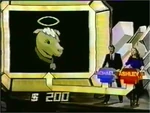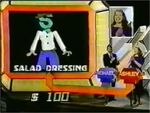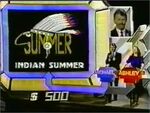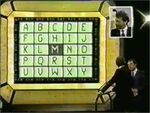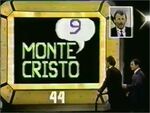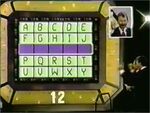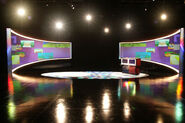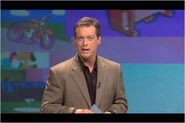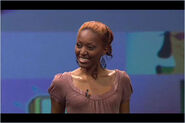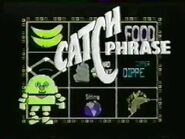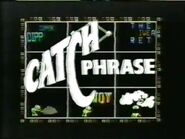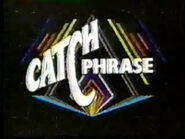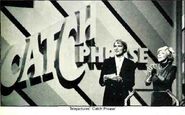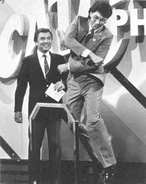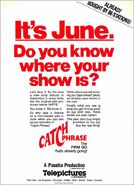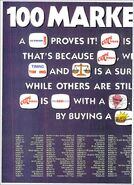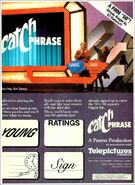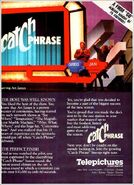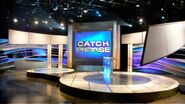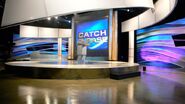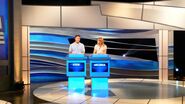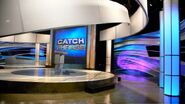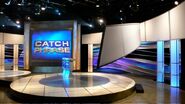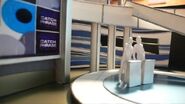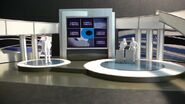| Hosts | |
| Rick Barry (1985, Pilot) Art James (1985–1986) Todd Newton (2006) [also announcer] | |
| Model | |
| Shana Forman (aka Mary Poms; 1985–1986) | |
| Announcer | |
| John Harlan (1985–1986) | |
| Broadcast | |
| Syndication (Daily): 9/16/1985 – 1/10/1986 Unsold Pilots (All New Catch Phrase): 2/5/2006 | |
| Packagers | |
| Pasetta Productions (1985-1986) Granada USA (2006) | |
| Distributor | |
| Telepictures (1985–1986) | |
1985 OPENING SPIEL:
"What is this Catch Phrase? You'll find out the answer to this and many more, as we play television's most exciting new game: Catch Phrase! And here's your host on Catch Phrase, Art James!"
2006 PILOT SPIEL:
"What is this Catch Phrase? You'll find the answer to this and many more, as we get ready to play tv's exciting game show: The All New Catch Phrase!
(All New) Catch Phrase was a short-lived game show where two contestants attempted to solve computer animated puzzles known as "Catch Phrases" in order to win cash & prizes worth as much as $75,000.
Gameplay[]
Main Game[]
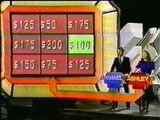
How much will each catch phrase be worth?
Two contestants competed; the returning champion stood at the blue podium, and the challenger stood at the red podium. At the start of each round, one player (the challenger at the start of the game, thereafter the trailing contestant) saw dollar amounts flashing in a randomizer. The contestant's job was to stop the randomizer by hitting his/her button. Whatever the dollar amount landed on became the value for the Toss-Up Catch Phrases.
The dollar amounts ranged from $100 to $200 in Round 1, $225 to $350 in Round 2, $375 to $500 in Round 3 and $525 to $700 in Round 4. At first, the amounts in Round 1 were $50 to $200 with amounts in Round 2 being $225 to $400. During the first taped week (which did not air until the week of Christmas), the dollar values ranged from $100 to $300 in Round 1, $150 to $400 in Round 2, and $175 to $500 in each succeeding round.
Toss-Up Catch Phrases[]
On each toss-up, the computer drew a popular catch phrase on the screen. Sometimes a robot named Herbie, the show's mascot, appeared in the catch phrase. His appearance and what he did acted as an important word in the answer. When the puzzle was finished or close to being finished, a bell sounded allowing the contestants to buzz-in. Upon buzzing in, a light leading from the buzz-in contestant's podium lit up in the buzz-in contestant's color leading up to the screen frame. A correct answer won the toss-up, but an incorrect answer gave the opponent a free shot, the opponent also got a free guess if the first player buzzed in too early before the bell. The first player to buzz-in with a correct answer added the landed money amount to the bank and received a chance to solve a Super Catch Phrase.
Some Catch Phrases were suggestions sent in by viewers of the show. If one of those suggestions was used, the person who sent it in was awarded a Catch Phrase t-shirt.
Super Catch Phrase[]
The Super Catch Phrase was a special Catch Phrase that was hidden behind nine squares with the show's logo on each. On each new turn at the Super Catch Phrase, the nine squares (or whatever squares were left) flashed in a randomizer just like the money amounts. The player in control hit his/her buzzer to stop the randomizer, which would land on a square causing it to be removed from the screen and reveal a piece of the puzzle. Then the contestant had five seconds to think of an answer.
A correct solution won all the money in the bank, but incorrect solution or failure to respond caused another Toss-Up Catch Phrase to be played. If neither player solved the Super Catch Phrase after all the squares were revealed, the money in bank was carried over into the next round. If time ran out in the middle of the round and neither player solved the Super Catch Phrase, the money in the bank goes unclaimed.
Several rounds (usually two or three) were played according to time, and when time ran out in the middle of a round, the rest of the current Super Catch Phrase was revealed and the first player to buzz-in with a correct answer won the money in the bank. Both players got to keep their cash, and the player with the most money when time was called won the game, became Catch Phrase champion and went on to the bonus round for big prizes.
Bonus Round[]
In the bonus round, the winning player faced a game board with 25 squares lettered A to Y. Behind those letters were Catch Phrases, with the most difficult one behind the letter M, the center square. The champion chose a square and tried to solve the hidden Catch Phrase behind it. The player could take as many guesses as he/she could, and a correct answer captured the square. But if the champ was stumped, he/she could pass on it and go back to it later. The object of the bonus was to get five squares in a row in 60 seconds or less.
If the contestant could get five in a row in a straight line (across or up & down) he/she won a prize package worth more than $5,000. But if the champ could get five in a row in any direction using the difficult M square, he/she won a $10,000 prize package. If time ran out and no five in a row was completed, the champion still won $200 for each captured square (with the total doubling if one of them was the M).
During the first taped week, each solved catch phrase would be worth a cash amount or other consolation prize while completing a line of five including the M square won a choice of one of three grand prizes.
Champions stayed on the show until they were defeated or won five games in a row. Five-time champions also won a bonus prize such as a new car, $10,000, or a new boat.
International Versions[]
Despite being a flop in the US, the show spawned numerous international versions including:
| Country | Local Name | Host | Network | Years Aired |
|---|---|---|---|---|
| Australia | Catch Phrase | John Burgess | Nine Network | 1997-1998 |
| Burgo's Catch Phrase | 1999-2001 2002-2003 | |||
| Greece | Vres ti Frasi Find the Words |
Miltos Makridis (1998-2000) Joyce Evidi (2000-2001) |
Mega Channel | 1998-2001 |
| Indonesia | Tebak Gambar Guess the Picture |
David Chalik | RCTI | 2001-2003 |
| Italy | Caccia alla Frase Hunting Sentence |
Peppe Quintale | Italia 1 | 1998 |
| Poland | O co chodzi? What is it? |
Agenieszka Wróblewska | TVN | 2000 |
| United Kingdom | Catchphrase | Roy Walker Nick Weir Mark Curry Stephen Mulhern |
ITV | 1986-1999 2000-2002 2002 2013-present |
| Family Catchphrase | Andrew O'Connor | The Family Channel (now called Challenge TV) | 1994 (only 50 episodes were produced for the short-lived series) | |
| Vietnam | Duoi hinh Bat Chu Finding Words by Looking at Pictures |
Xuan Bac | Hanoi Radio Television | 2003-2019 |
2006 Unsold Pilots[]
Twenty years later, in 2006; Granada USA shot two pilots for a potential revival of the short-lived show with Todd Newton as host. Unfortunately, it didn't sell.
Main Game[]
The game was played in three rounds.
The First Two Rounds[]
These rounds were just like the original version except every Catch Phrase added cash to the player's total and solving the Super Catch Phrase won bonus cash.
Round 1[]
Each Catch Phrase was worth $150 to $400 and solving the Super Catch Phrase won an extra $1,000.
Round 2[]
Each Catch Phrase was worth $400 to $800 and solving the Super Catch Phrase won an extra $1,500.
Round 3[]
Round 3 was played with nothing but toss-ups (no supers). Prior to each Catch Phrase, the trailing player would set the amount for the upcoming Catch Phrase ($800 to $1,500). When time was up, the player in the lead was the winner.
In the bonus round, each Catch Phrase was worth $1,000. Getting 5 in a row won $10,000, but getting 5 in a row using the M won $20,000.
Gallery[]
Unsold Pilots for Revivals[]
There were two attempts to revive Catch Phrase but under new names and altered rules.
Puzzle Roulette[]
- Main article: Puzzle Roulette
In 1987, an unsold pilot revival of this show called Puzzle Roulette was also produced by Marty Pasetta Productions along with Proctor & Gamble Productions. Hosted by the late Jim Lange and co-hosted by Shari Paulson, four contestants competed in a game of chance with a spinning roulette wheel while solving "catch phrases".
The Puzzle Game[]
- Main article: The Puzzle Game
In 1989, an unsold pilot revival of this show called The Puzzle Game was also produced by Marty Pasetta Productions and also hosted by the late Jim Lange. This show is basically the same as the original show but with couples playing.
More Pictures[]
1985-1986 Run[]
Logos[]
B&W Photos[]
Trade Ads[]
A Pilot Set[]
Music[]
Ray & Marc Ellis
Inventor[]
Stephen Radosh
Rating[]
Studio[]
Studio 1, Metromedia Studios, Los Angeles, CA
Tagline[]
"This has been a Pasetta Production, in association with Telepictures." - John Harlan
Additional Page[]
Links[]
Rules for Catch Phrase @ loogslair.net
James Vipond's Catch Phrase Page
Catch Phrase Pilot Set



